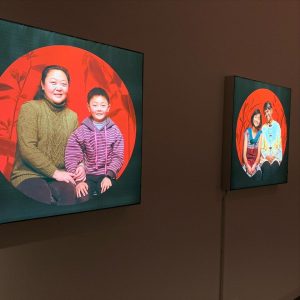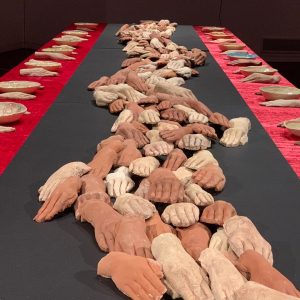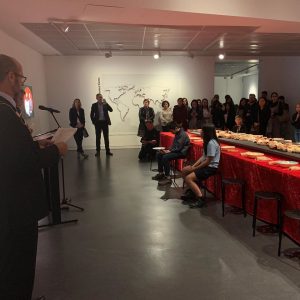Case Study 3: Far Flung: Connecting Intergenerational Families
Doncaster, Melbourne, Victoria, Australia
Far Flung: Connecting Intergenerational Families was a collaborative art project resulting in an exhibition at the Manningham Art Gallery in the Naarm suburb of Doncaster. The collaboration was developed between a Social-Artist-in-Residence team who worked with eleven new immigrant families to curate an art project from June to September 2019, with the exhibition occurring in November. The exhibition re-imagined the gallery spaces as the shared metaphoric local/global home of these transnational families. The front ‘lounge room’ presented the journey of the collaboration via video and soundscape. The second, larger gallery transformed into a shared dining room with twenty-two seats around a large table. The table held an installation of the many hands of the project’s participants. The walls were adorned with their portraits, demonstrating their presence whilst their seats were empty to signify their absence in the local narratives of place. Through the collaborative project development, the participants began to make their own place in society.

Manningham is a local government area in the north-eastern suburbs of Naarm which has experienced fast population growth in recent years due to increased migration as a result of employment opportunities. Doncaster in particular has seen an increase in urban density with the building of large-scaled apartment blocks to accommodate new populations. Birralee Primary School in Doncaster Hill experienced huge growth as a school in the five years leading up to the project (2013-19) from 125 to 500 students. As identified in the project, many of these new residents are from surrounding Asia-Pacific countries, and a significant portion have Chinese heritage. Doncaster also appeals to these families as it is a suburb neighbouring Box Hill, a Chinatown in eastern Melbourne. The high concentration of residents with Chinese ancestry and large number of Chinese restaurants, cafés and grocers (Scanlon Foundation Research Institute, 2020) give local families easy access to cultural food, supplies, services and community.
The families of Far Flung were selected from the local Birralee Primary School community, and had migrated to Australia mostly from the Asia-Pacific region including China, Taiwan, Hong Kong, Korea, Malaysia, Vietnam and Colombia, reflecting the growing and evolving diversity of Doncaster, Manningham. In consultation with the art and language educators of the school, the school identified new immigrant students who would be suitable for the program, as they recommended extracurricular social and creative activities would be beneficial to their experience of settling in Melbourne. The families who participated were comprised of a parent / guardian and a child of upper primary school age (levels 3-6 / aged 7-12). We included guardians as many children were also cared for by their grandparents, but none officially joined the collaboration, though some did attend our activities. Many of these transnational families experienced living between countries, as their parents attended to work and business commitments overseas.
Based on my earlier projects as a socially-engaged artist, we developed a Social-Artists-in-Residence Team comprising of myself (lead artist and curator), Sofi Basseghi and Katayoun Javan (photography and video), Ai Yamamoto (sound), Amy Kennedy and Yuso Lee (ceramics), and Rongping Jiang (family support and translator) with support from Manningham’s Arts and Cultural team. Far Flung was funded by Creative Victoria’s Creative Suburbs[1] program and the City of Manningham, resulting in further scope to work with artists of diverse skills. The two earlier case studies Belonging (2016) and The Anonymous Sojourners (2017) were much smaller in scale, requiring that I work as the artist, curator and project manager with collaborating communities. This larger group of artists and participants required a different focus of me as the artistic lead of the project, with more significance placed on project management and staggering the stages of the collaborative creative process.
The physical landscape of Doncaster is highly urbanised, dominated by freeway infrastructure and located on a hill which creates a wind tunnel in its centre. These strong winds make the central communal spaces impractical for community congregation outdoors. The central area is dominated by Westfield Doncaster, a large scale indoor shopping centre predominantly accessed by car. Manningham Local Government has better resources for arts and cultural facilities than in the previous neighbourhoods in which I had worked, perhaps to counterbalance the dominance of retail in the central business precinct with arts, cultural, educational and social activities. In particular, Manningham’s MC2 facility acts as a central community hub with the library, art gallery and café on the entry level, community services (such as Chinese Social Services) on Level 2 and art studios for visual arts, ceramics, dance and performance and community spaces on the top floor. In comparison to my earlier experiences, this access to such a range of professional facilities was a luxury, meaning my role as the lead artist and curator could be more focused on production.
This collaboration was significantly more structured than previous projects due to the number of people involved, numbering eight artistic collaborators and twenty-two participants in total. The collaboration occurred over a ten-week period during Term 3 of the primary school year, with participants meeting each Friday for 1.5 hour workshops. As in action research processes, we followed the cycle of developing, acting, observing and reflecting.
The first stage focused on getting to know each other and the local place through creative participatory workshopping. We were thereby able to conceptualise their shared and individual perceptions of local place, how they saw themselves as new immigrants in Doncaster. This process was insightful, as it revealed intergenerational differences and also encouraged learning across the group between adults, children and artists, who were not necessarily locally based.
In the second stage, we focused on working in the ceramics studio and exploring various concepts through ceramics. This stage also involved discussions on contemporary art and how artists work in collaboration with communities. We discussed examples to understand various artists’ strategies, roles of the members of the collaboration and the narratives conveyed about a particular community through the content which was produced. During this period we also drew from Manningham’s collection and ceramic art focus to understand how ceramics are used as a vehicle to express different societal ideas. By observing and reflecting upon our group conversations, we identified and developed various narratives which articulated their circumstances, such as their journeys to Australia and their communities in Australia. I visually presented these ideas as rough sketches of potential project plans and offered alternatives to the families. To democratise the decision-making process, we voted on the design with which the participants wanted to proceed, choosing to develop an installation of their ceramic hands, which would be displayed on a shared dining room table to show how we had connected through the process. From this central idea, we focused on establishing table settings for each person in the group to signify that they had their own space at the table and mark their presence in the community. These concepts formed the direction for our studio work during the following weeks.

The final stage involved the preparation of the artworks for installation in the gallery and the development of public programs to communicate their ideas with the wider audience. The public showing of the work with the school and wider community led to the acknowledgement of new and emerging community voices, critical to demonstrating public recognition of the changing population of the local community. During the opening, a local resident came to speak to me, complimenting the inclusiveness of the project. He reflected upon his own experience as an Australian of Italian descent, discussing his experiences of racial tension and not being accepted in the local area during his youth in the 1970s. He expressed how proud he was that his local area had dramatically improved and was not only able to publicly celebrate the stories of diversity in the local area.

- Creative Victoria’s Creative Suburbs program was an initiative of the Creative State Strategy, Victorian Government, to support Metropolitan Councils in developing creative projects with local communities (2016-19). ↵
